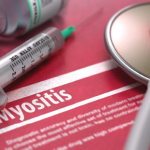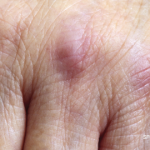I pulled up her bloodwork, and the few images she had brought with her.
“I don’t have enough data yet,” I said, placing a hand on hers. “But judging by your history and exam,”—she stared at me—“the rash around your eyes, posterior neck, left arm, the back of your hands and feet; the way your muscles have weakened and wasted so quickly; and these hard lesions,” I pointed at the ridges of calcinosis around her joints, on her jaw, arms and pressure points, “I think you have a form of dermatomyositis.”
Her mother gripped her wheelchair. They were so quiet. I wondered for a moment if she had been a loud teenager, if she loved blasting songs from her car, maybe sang madly sometimes when she ran like the wind on a cool morning. I didn’t ask her.
Discussion
Dermatomyositis is a sinister autoimmune disease. A subset of inflammatory myopathies, the disease manifests with a spectrum of rashes most pronounced on the back of the hands, around the neck, eyes and shoulders, as well as significant muscle weakness, ranging from amyopathy to severe polymyopathy. It can start with either skin or muscle involvement and can be difficult to diagnose, especially because some of the antigen-specific antibodies that drive the inflammatory response weren’t even discovered until this past decade. More and more such antibodies are being discovered yearly, so the standard tests many community physicians rely on can produce misleading results.
A particular subset of dermatomyositis, once called dermatomyositis sine myositis and now known as clinically amyopathic dermatomyositis (CADM), can be particularly tricky to diagnose, because many patients may not have any muscle involvement at the onset of disease. The antibody most often associated with this subset, the anti-MDA5 or anti-CADM 140, is not part of the standard myositis panel and must be specifically ordered. This antibody-specific myositis can exhibit rapidly progressive interstitial lung disease, severe erosive arthritis and mechanic’s hands—cracking and thickening of the skin in the eponymous organ.
My young patient would eventually turn out to have this particular antibody.
We talked some more. I brought my attending in. We examined her together. We believed we had the correct diagnosis.
Did she look relieved? I suspect we might have given her some hope. Her eyes were brighter. When, gentle as we could, we told her we would—perhaps—not be able to restore her to prior function and that much of the damage to her joints was likely irreversible, tears slipped down her cheeks. Her chest hitched only once. I don’t know if she knew she was crying.



